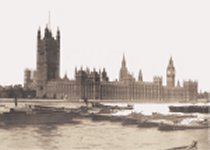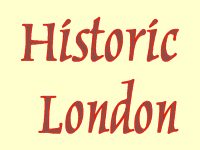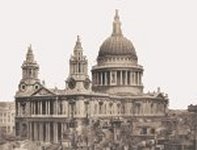|
|
Introduction
London is, to misquote Charles Dickens, a 'Tale of Two Cities'. One is the City of London (the centre for commerce), the other the City of Westminster (the centre of government). Once separate, the two ran into one another in Medieval times.
Once the City of London had been made secure by William the Conqueror his son, William II, effectively founded the City of Westminster by building Westminster Hall close to the existing Westminster Abbey. This established Westminster as the seat of National government.
For our journey around the sights of Victorian London we will start from St James' tube station. From the station walk forwards down The Broadway, past the new New Scotland Yard and into Victoria Street.
|
VICTORIA STREET, WESTMINSTER, WITH THE ARMY AND NAVY STORES.
Victoria Street is a modern thoroughfare, stretching from Broad Sanctuary to the railway termini known as Victoria Station. It extends for more than a thousand yards, and is eighty feet broad. On either side are enormous buildings, ranging from five to eight storeys high, and consisting chiefly of residential flats. One monster block, on the south side, at about the middle, is occupied by the Army and Navy Stores, where innumerable people do nearly all their shopping; and there are invariably a row of carriages and a crowd of dogs waiting outside the entrance beneath the clock. The making of Victoria Street did away with a number of slums that gave Westminster a bad reputation, which now it no longer deserves.
|
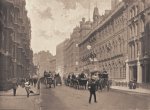
|
|
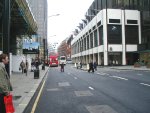
|
Nowadays Victoria Street is always bustling. At the Westminster end, towards which you are facing, are many government offices; The Department for Trade and Industry (DTI) and International Development are but two of them. Just behind where this picture is taken from is Westminster City Council offices. The white building in the centre of the picture is what was the Army & Navy stores, 101 Victoria Street. The A&N was absorbed into the House of Fraser store chain and has lost its individual identity. From here, to your right, you can get to Victoria Station and Westminster Catholic Cathedral.
Walk forwards, down Victoria Street, towards Parliament Square passing through Broad Sanctuary.
|
|
Parliament Square
|
LORD BEACONSFIELD'S STATUE ON PRIMROSE DAY, 1895.
In the open space known as Parliament Square is the bronze statue of Lord Beaconsfield, facing St. Margaret's Church. The statesman is shown in the robes of the Garter, and the figure, executed by Raggi, was unveiled two years after Lord Beaconsfield's death. It was on April 19th, 1881, that the Conservative leader died, and the anniversary of that day is now celebrated as Primrose Day. Every year the statue is beautifully decorated with primroses, as shown in our picture, the primrose being regarded by the Earl's political admirers as his favourite flower; although others maintain that he looked upon this pledge of spring in much the same fashion as did Peter Bell. The wreaths, mottoes, and other devices are sent from all parts of the country, and are allowed to remain until they are faded.
|
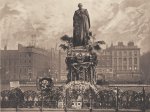
|
|
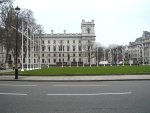
|
As you can see from this, and the pictures below, Parliament Square has been remodeled considerably since 1896. Lord Beaconsfield's statue has been moved over to the left in this picture, now facing the Houses of Parliament rather than St Margaret's.
Parliament Square became London's first official roundabout in 1926. |
 |
|
|
Westminster Abbey
The bulk of the building that you see in the photo was built during the 13th Century. This Abbey was built on the site of an older building, the first here was in the 10th Century.
St Margaret's Church, which stands next to the Abbey on its North side, is the parish church for Westminster and the houses of Parliament and was built largely in the 15th Century. In 1973 it ceased to be an independent parish church and came under the care of the Dean of the Abbey.
|
WESTMINSTER ABBEY, VIEW FROM THE NORTH.
It is impossible to get a view of the whole length of Westminster Abbey without including St. Margaret's Church, which, however, is itself of considerable interest from its associations with Parliament, and as having been founded by Edward the Confessor. But all secondary claims are forgotten beside the noble Abbey, where all our monarchs since Harold have been crowned, and where so many other historic scenes have been enacted. It was founded in 616, restored by the Confessor, and later by various English kings. Fourteen kings and as many queens are buried within its walls ; and here also rest crowds of great men whose names are household words wherever the English tongue is spoken. The Abbey is 375 feet in length, and measures 200 feet across the transepts.
|
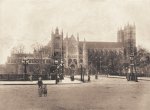
|
|
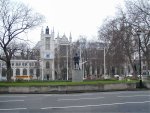
|
Parliament Square, originally laid out in the 1840s, now extends further to the right (west) than in the Victorian photo and is frantically busy. This modern photo has been digitally retouched to remove the constant stream of traffic and give a clear view.
|
|
Houses of Parliament
Parliamentary - representative - democracy was a direct result of the signing of the Magna Carta in June 1215 between the barons of Medieval England and King John at Runnymede near Windsor Castle. The two Houses of Parliament, the Commons and the Lords, have been meeting at Westminster Palace since the early 1500s.
|
THE HOUSES OF PARLIAMENT.
To gain the best view of the Houses of Parliament it is necessary to venture upon the
Thames. This new Palace of Westminster dates from 1840; and Sir Charles Barry's designs were
adopted in preference to ninety-six other plans submitted in competition. It belongs to the
Tudor style of architecture, and is highly ornate. The Houses cover eight acres, boast more
than 1,100 rooms, and have cost some three millions. The Clock Tower is easily distinguishable,
and is 318 ft. high, or 18 ft. more than the Middle Tower, while the Victoria Tower is 340 ft.
in height. Through the Victoria Tower the Queen passes when she opens Parliament, and beyond
it will be noticed the towers of Westminster Abbey. By the riverside is the Terrace, where,
in summer, legislators seek fresh air and entertain ladies at afternoon tea.
|
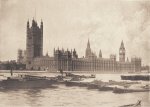
|
|

|
Not a lot has changed visually since 1896. The waterborne traffic now has the emphasis on leisure rather than work, but parliament goes on.
|
|
Westminster bridge
London bridge was the first bridge across the river, Westminster the second.
|
WESTMINSTER BRIDGE.
The view from the Surrey side, west of the graceful Westminster Bridge,
is a striking one. In our picture, to the left, is seen the east end of the
House of Commons and of the Terrace, with the Clock Tower. At the corner of
the block of buildings in the centre is St. Stephen's Club, much frequented
by Conservative legislators. The large structure in the baronial style to the
right is New Scotland Yard, the headquarters of the Metropolitan Police, of
which a nearer view appears on plate 95. Westminster Bridge, built by Page
in 1856-62, consists of seven iron arches on granite piers, and the arch
through which the barges are passing has a span of 120 feet. It was from
the bridge which the present one superseded that Wordsworth had the view
which inspired one of the most familiar of his sonnets.
|
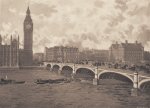
|
|
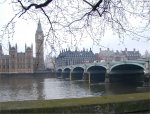
|
St Stephen's Club has gone and the building replaced with a modern office suite for Members of Parliament called Portcullis House designed by Norman Shaw. Its style mirrors that of the old New Scotland Yard building to the right and the exterior neatly mimics the shape of the portcullis symbol used by the Houses of Parliament.
It sits on top of the completely rebuilt Westminster tube station; a spacious station in the modern style of which our city can be justly proud.
Click here to move on to the Westminster Riverside.
|
|
|
